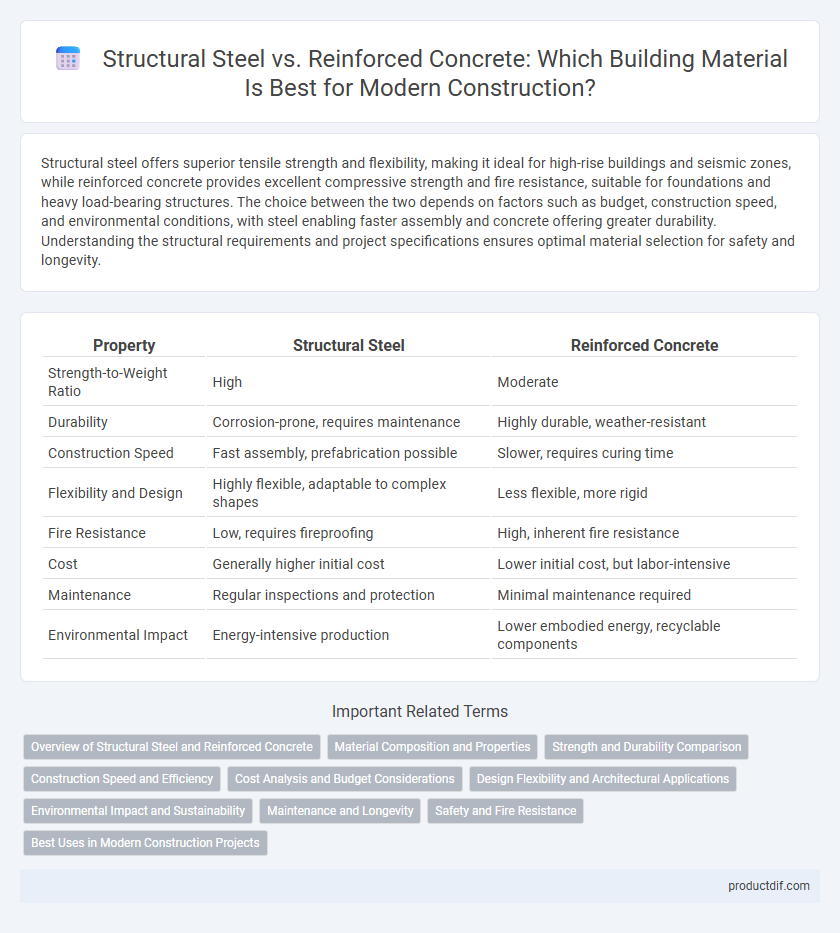Structural steel offers superior tensile strength and flexibility, making it ideal for high-rise buildings and seismic zones, while reinforced concrete provides excellent compressive strength and fire resistance, suitable for foundations and heavy load-bearing structures. The choice between the two depends on factors such as budget, construction speed, and environmental conditions, with steel enabling faster assembly and concrete offering greater durability. Understanding the structural requirements and project specifications ensures optimal material selection for safety and longevity.
Table of Comparison
| Property | Structural Steel | Reinforced Concrete |
|---|---|---|
| Strength-to-Weight Ratio | High | Moderate |
| Durability | Corrosion-prone, requires maintenance | Highly durable, weather-resistant |
| Construction Speed | Fast assembly, prefabrication possible | Slower, requires curing time |
| Flexibility and Design | Highly flexible, adaptable to complex shapes | Less flexible, more rigid |
| Fire Resistance | Low, requires fireproofing | High, inherent fire resistance |
| Cost | Generally higher initial cost | Lower initial cost, but labor-intensive |
| Maintenance | Regular inspections and protection | Minimal maintenance required |
| Environmental Impact | Energy-intensive production | Lower embodied energy, recyclable components |
Overview of Structural Steel and Reinforced Concrete
Structural steel is a high-strength alloy composed primarily of iron and carbon, known for its durability, flexibility, and rapid construction capabilities in building frameworks. Reinforced concrete combines concrete's compressive strength with steel reinforcement bars, enhancing tensile strength and providing excellent fire resistance and longevity. Both materials serve critical roles in construction, with steel offering superior modularity and concrete delivering cost-effective, robust structural support.
Material Composition and Properties
Structural steel consists primarily of iron alloyed with carbon and other elements, providing high tensile strength and flexibility, ideal for withstanding dynamic loads and seismic forces. Reinforced concrete combines concrete's compressive strength with steel rebar's tensile capacity, creating a composite material that excels in durability and fire resistance. The material composition directly influences their properties: steel offers faster construction and lighter structures, while reinforced concrete provides superior mass and thermal insulation.
Strength and Durability Comparison
Structural steel offers superior tensile strength and flexibility, making it ideal for high-rise buildings and structures requiring resistance to dynamic loads and seismic activity. Reinforced concrete excels in compressive strength and provides excellent durability against weathering, corrosion, and fire, often requiring less maintenance over time. While steel can be susceptible to corrosion without protective coatings, reinforced concrete's composite nature enhances its long-term structural integrity in diverse environmental conditions.
Construction Speed and Efficiency
Structural steel offers significantly faster construction speed compared to reinforced concrete due to its prefabrication and modular assembly, reducing on-site labor time. Steel components can be rapidly erected, allowing for quicker project completion and earlier occupancy. Reinforced concrete requires curing time, which delays progress and affects overall efficiency in tight construction schedules.
Cost Analysis and Budget Considerations
Structural steel generally incurs higher initial material and fabrication costs compared to reinforced concrete but offers faster construction times, potentially reducing overall labor expenses. Reinforced concrete typically provides lower material costs and greater thermal mass, contributing to energy savings, though it demands longer curing periods impacting project timelines. Budget considerations must balance upfront expenses against lifecycle costs, project duration, and structural performance requirements to determine the optimal choice.
Design Flexibility and Architectural Applications
Structural steel offers superior design flexibility with its high strength-to-weight ratio, allowing for longer spans and more intricate architectural forms compared to reinforced concrete. Reinforced concrete provides excellent compressive strength and fire resistance but is more limited in shape complexity due to its rigidity and curing time. Architects prefer structural steel for innovative, lightweight designs, while reinforced concrete remains ideal for robust, load-bearing structures and complex contours.
Environmental Impact and Sustainability
Structural steel offers high recyclability, reducing waste and minimizing environmental impact during demolition, while its production generates significant carbon emissions. Reinforced concrete has a lower embodied energy compared to steel but relies heavily on cement, a major source of CO2 emissions, though its thermal mass contributes to energy efficiency in buildings. Sustainable construction practices incorporate recycled steel and supplementary cementitious materials to mitigate the environmental footprint of both materials.
Maintenance and Longevity
Structural steel offers superior durability with minimal maintenance requirements, resisting corrosion when properly treated and coated. Reinforced concrete provides excellent longevity, especially in aggressive environments, but may need periodic repairs to address cracking or spalling caused by environmental stressors. Both materials require tailored upkeep strategies to maximize their lifespan in construction projects.
Safety and Fire Resistance
Structural steel offers high tensile strength and ductility, enhancing safety by allowing buildings to withstand dynamic loads such as earthquakes and wind. Reinforced concrete provides superior fire resistance due to its non-combustible nature and thermal insulation properties, maintaining structural integrity during prolonged fire exposure. Choosing between these materials depends on project requirements for load-bearing capacity versus fire safety performance.
Best Uses in Modern Construction Projects
Structural steel provides high strength-to-weight ratio and flexibility, ideal for skyscrapers, long-span bridges, and industrial buildings requiring rapid construction and design adaptability. Reinforced concrete offers superior compressive strength and durability, making it best suited for foundations, dams, and infrastructure with heavy load requirements and exposure to harsh environmental conditions. Modern construction projects often integrate both materials to optimize structural performance, cost-efficiency, and resilience.
Structural Steel vs Reinforced Concrete Infographic

 productdif.com
productdif.com